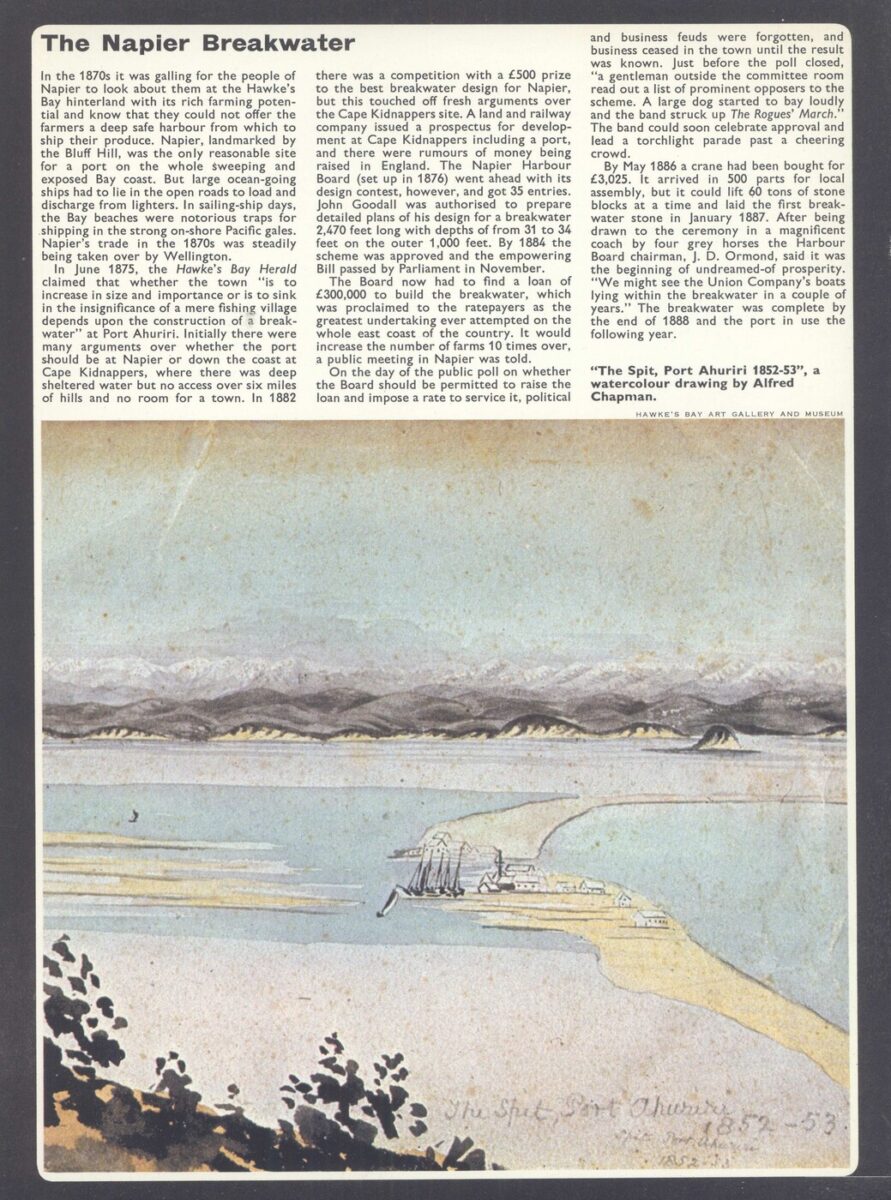The Napier Breakwater
In the 1870s it was galling for the people of Napier to look about them at the Hawke’s Bay hinterland with its rich farming potential and know that they could not offer the farmers a deep safe harbour from which to ship their produce. Napier, landmarked by the Bluff Hill, was the only reasonable site for a port on the whole sweeping and exposed Bay coast. But large ocean-going ships had to lie in the open roads to load and discharge from lighters. In sailing-ship days, the Bay beaches were notorious traps for shipping in the strong on-shore Pacific gales. Napier’s trade in the 1870s was steadily being taken over by Wellington.
In June 1875, the Hawke’s Bay Herald claimed that whether the town “is to increase in size and importance or is to sink in the insignificance of a mere fishing village depends upon the construction of a break-water” at Port Ahuriri.
Initially there were many arguments over whether the port should be at Napier or down the coast at Cape Kidnappers, where there was deep sheltered water but no access over six miles of hills and no room for a town.
In 1882 there was a competition with a £500 prize to the best breakwater design for Napier, but this touched off fresh arguments over the Cape Kidnappers site. A land and railway company issued a prospectus for development at Cape Kidnappers including a port, and there were rumours of money being raised in England. The Napier Harbour Board (set up in 1876) went ahead with its design contest, however, and got 35 entries. John Goodall was authorised to prepare detailed plans of his design for a breakwater 2,470 feet long with depths of from 31 to 34 feet on the outer 1,000 feet. By 1884 the scheme was approved and the empowering Bill passed by Parliament in November.
The Board now had to find a loan of £300,000 to build the breakwater, which was proclaimed to the ratepayers as the greatest undertaking ever attempted on the whole east coast of the country. It would increase the number of farms 10 times over, a public meeting in Napier was told.
On the day of the public poll on whether the Board should be permitted to raise the loan and impose a rate to service it, political and business feuds were forgotten, and business ceased in the town until the result was known. Just before the poll closed, “a gentleman outside the committee room read out a list of prominent opposers to the scheme. A large dog started to bay loudly and the band struck up The Rogues’ March.” The band could soon celebrate approval and lead a torchlight parade past a cheering crowd.
By May 1886 a crane had been bought for £3,025. It arrived in 500 parts for local assembly, but it could lift 60 tons of stone blocks at a time and laid the first breakwater stone in January 1887. After being drawn to the ceremony in a magnificent coach by four grey horses the Harbour Board chairman, J. D. Ormond, said it was the beginning of undreamed-of prosperity. “We might see the Union Company’s boats lying within the breakwater in a couple of years.” The breakwater was complete by the end of 1888 and the port in use the following year.
“The Spit, Port Ahuriri 1852-53”, a watercolour drawing by Alfred Chapman.
HAWKE’S BAY ART GALLERY AND MUSEUM












Do you know something about this record?
Please note we cannot verify the accuracy of any information posted by the community.